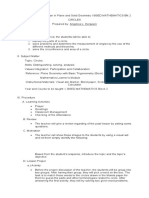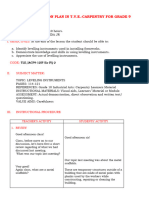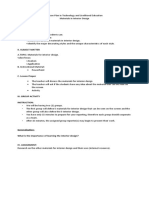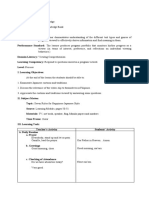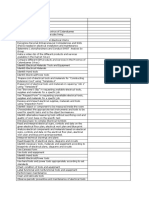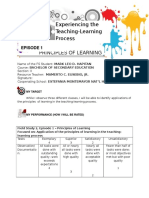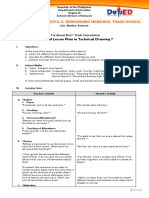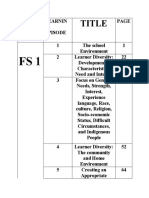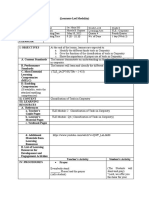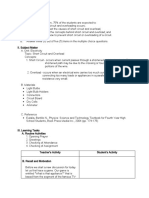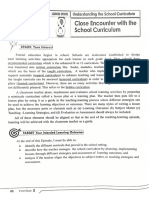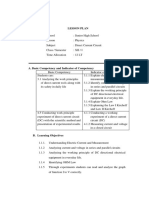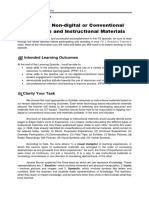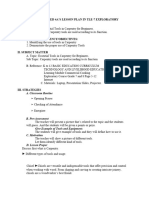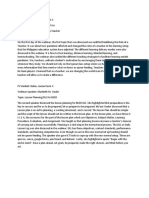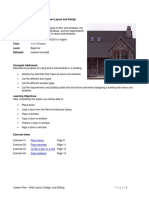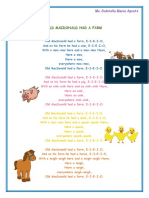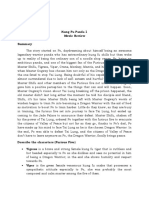A Semi-Detailed Lesson Plan in First Year ART
Materials for Building Furniture
I. OBJECTIVES
At the end of the lesson, students should be able to:
A. define what is doors and windows;
B. explain the importance of doors and windows;
C. identify the different types of doors and windows.
II. SUBJECT MATTER
Major Topic : Doors and Windows
Sub Topic : Different Types of Doors and Windows
Values Integrated : Appreciation and Thinking Skills
Instructional Materials: Traditional Visual Aids and PowerPoint
Presentation
References :
Planning and Desginers Handbook by Max Fajardo
Fenestration.pptx
https://learning.oreilly.com/library/view/basic-civil-
engineering/9788131729885/xhtml/chapter017.xhtmn
III. PROCEDURE
B. Preparatory Activities
1. Daily Routine
a. Greetings
b. Classroom Management
c. Prayer
d. Checking of Attendance
e. Collecting of Assignments
2. Review
a. Define Fenestration?
b. What are the Types of Fenestration?
3. Motivation
Let students to perform the “What is it Song”. (The teacher will
present the video)
�B. Presentation of the Lesson
1. Introduction
Doors and windows are important elements of a structure. It
provides aesthetic and function for both the users and structures.
2. Lesson Proper
A door is a movable barrier secured in an opening, known as
the doorway, through a building wall or partition for the purpose of
providing access to the inside of a building or rooms of a building. A
window is defined as an opening in a wall or building to serve one
or more of the functions like natural light, natural ventilation and
vision.
Why Doors and Windows are required?
Privacy
Security
Safety
Ventilation
Natural Light
Climate Control
Prevent spreading of fire
Barrier to noise
Aesthetic and more
Types of Doors
Single Lift and Double Lift door
Swing door
Sliding door
Pocket door
By-pass door
Bi fold door
Accordion door
Tilt-up Garage door
Sectional Garage door
Types of Windows
Transom window
Awning window
Hopper window
Pivot window
Casement window
Sliding window
Hung window
� Picture window
Bay window
Bow window
Curtain Wall
Special Shape window
3. Application
Peer Group Activity (The class will be group into two groups,
which will be known as Group’s A and B)
Direction: Identify the pictures to be shown, each group member
have the chance to raise their hand if they know the answer. The
group with the highest number to identify wins.
4. Generalization
Doors and windows are defined as an important element of a
structure as it provides a lot of function. There are different
types of doors and windows that can be classified by their
mechanism.
IV. EVALUATION
Paper and Pencil Test
Direction: In a ¼ sheet of yellow paper, answer the following:
1. Define what is doors and windows
2. Name at least 2 types of door and 3 types of window
3. Give at least 3 purposes of doors and windows
Key to correction:
1. A door is a movable barrier secured in an opening. A window is
defined as an opening in a wall.
2. Atleast 2 of the following:
Types of Doors
Single Lift and Double Lift door
Swing door
Sliding door
Pocket door
By-pass door
� Bi fold door
Accordion door
Tilt-up Garage door
Sectional Garage door
Atleast 3 of the following:
Types of Windows
Transom window
Awning window
Hopper window
Pivot window
Casement window
Sliding window
Hung window
Picture window
Bay window
Bow window
Curtain Wall
Special Shape window
3. Atleast 3 of the following:
Privacy
Security
Safety
Ventilation
Natural Light
Climate Control
Prevent spreading of fire
Barrier to noise
Aesthetic and more
V. ASSIGNMENT
A. Follow up
Direction: In a short bond paper, make a research about the different
materials that can be use for doors and windows. To be submitted on
Monday.
B. Advanced
Direction: Review about the standard sizes of doors and windows for
residential and commercial buildings, and prepare for recitation next
meeting.
�References:
Planning and Desginers Handbook by Max Fajardo
Fenestration.pptx
https://learning.oreilly.com/library/view/basic-civil-
engineering/9788131729885/xhtml/chapter017.xhtmn
Prepared by:
Jhoyvhie G. Nolasco
Checked by:
Prof. Julieta M. Fajardo

